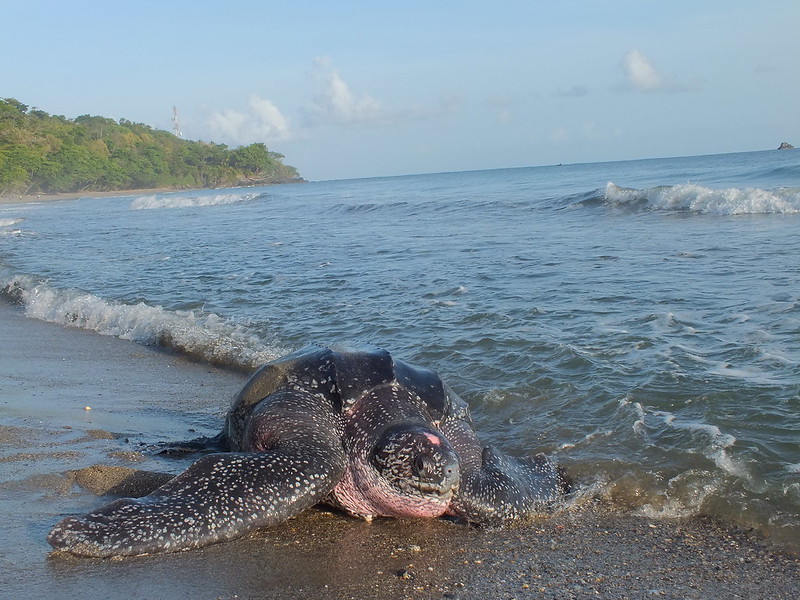Creature Feature: Leatherback Turtles!
Giant Leatherback heading back to sea by OasisMarigot
By Lizzy Ashley
Everything is bigger in the Pacific Northwest, from giant octopuses to towering plumose anemones. It’s only fitting that the world’s largest sea turtle, the leatherback (scientific name Dermochelys coriacea), visits the water surrounding the Salish Sea! These massive reptiles travel from their nesting beaches in southeast Asia to feed along the western coast of North America every year, including the outer coast of Washington.
Sea turtle or soft-top VW Beetle?
Leatherbacks are unique turtles. They weigh up to a ton, grow to over 6 feet in length, and do not have hard scales and shells like other sea turtles. Their long carapace, or top shell, is instead rubbery skin that covers thousands of coin-shaped bony plates. This explains their scientific name Dermochelys coriacea, which means “leathery skin-turtle.” Seven ridges line the carapace, allowing the leatherback to glide through the water during long-distance migrations. It’s no wonder the leatherback also has the reputation of fastest aquatic reptile!
Living dinosaurs
Heat generated by swimming, a large body size, and a thick fat layer help the leatherback stay warm in high-latitude waters and on dives up to 4,000 feet deep. Their giant size is so important to their ability to retain heat that scientists call them “gigantotherms,” a title that leatherbacks share with dinosaurs. This name isn’t the only thing these creatures have in common - the ancestors of today’s leatherbacks actually shared the planet with dinosaurs 110 million years ago. The leatherback is the only non-extinct species in the family of turtles that swam in prehistoric seas before hard-shelled sea turtles existed. If you see a leatherback, you are meeting a modern dinosaur!
Leatherback sea turtle by Maarten Roggeman
Cosmopolitan jelly-eaters
The leatherback is a cosmopolitan species, meaning it lives all over the world. In fact, leatherbacks are the most migratory and wide-ranging marine reptile around. Why would a sea turtle travel as many as 10,000 miles a year? Well, if you’ve ever had a craving for your favorite food, you might understand. Leatherbacks migrate in search of jellyfish and other soft invertebrates to eat. Special spines in the turtle’s esophagus ensure slippery jellies only travel in one direction: toward the stomach! Each year, western Pacific leatherbacks will cross the Pacific Ocean from nesting areas in Asia to the west coast of North America just to forage for jellies. Because they keep jellyfish populations in check, leatherbacks play an important role in marine ecosystems.
Surf ‘n’ Turf
Like other sea turtle species, a leatherback crawls ashore at night to lay her eggs in a chamber that she digs with her back flippers. A leatherback lays multiple nests of around 80 eggs during a nesting season, which typically occurs every few years. After a couple of months incubating in the sand, hatchling turtles emerge from the nest and crawl back to the ocean. Leatherbacks nest on every continent except Europe and Antarctica. Unlike other sea turtles, females may change nesting beaches throughout their lives. They prefer to nest in warmer areas near the equator, so don’t count on seeing a leatherback nest in Washington.
Photo by Mira Lutz Castle
Turtle trouble
Leatherbacks are endangered due to threats like illegal egg harvesting, bycatch in fishing gear, climate change, and marine debris (ocean trash). To help leatherbacks, we should all reduce our use of plastics and support efforts to protect sea turtles around the world. We can also spread the word that sea turtles live in our own backyard. Keep an eye out for leatherback turtles swimming and snacking off the coast of Washington (and Oregon, California, British Columbia) next summer and fall!



